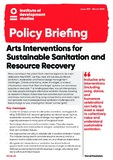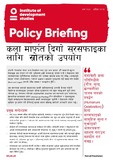Arts Interventions for Sustainable Sanitation and Resource Recovery
कला माफर्त दिगो सरसफाइका लागि स्रोतको उपयोग
| dc.contributor.author | Macpherson, Hannah | |
| dc.coverage.spatial | Nepal | en |
| dc.date.accessioned | 2023-03-20T11:47:10Z | |
| dc.date.available | 2023-03-20T11:47:10Z | |
| dc.date.issued | 2023-03-20 | |
| dc.identifier.citation | Macpherson, H. (2023) 'Arts Interventions for Sustainable Sanitation and Resource Recovery', IDS Policy Briefing 209, Brighton: Institute of Development Studies, DOI: 10.19088/IDS.2023.013 | en |
| dc.identifier.citation | Macpherson, H. (2023) कला माफर्त दिगो सरसफाइका लागि स्रोतको उपयोग, IDS Policy Briefing 210, Brighton: Institute of Development Studies, DOI: 10.19088/IDS.2023.019 | |
| dc.identifier.issn | 1479-974X | |
| dc.identifier.uri | https://opendocs.ids.ac.uk/opendocs/handle/20.500.12413/17911 | |
| dc.description.abstract | Many countries in the global South declare regions to be open defecation free (ODF), but they must still address significant sanitation, wastewater, and faecal sludge management challenges. Climate uncertainty, water shortages, and weak infrastructure mean that ‘flush and forget’ systems are not always possible or desirable. This briefing describes how art interventions can help people reimagine alternative sanitation futures. Drawing on research in Nepal, it describes how activities such as dance workshops, humanure planting, song competitions, and radio jingles can generate new knowledge about sanitation challenges and faecal sludge re-use, showing that ‘brown’ can be ‘gold’! | en |
| dc.description.abstract | दक्षिणी गोलार्धमा रहेका अल्प–बिकसित तथा न्युन आय भएका धेरै देशहरुले खुल्ला दिसामुक्त क्षेत्र घोषणा गरे पनि उनीहरुले अझै सरसफाई, फोहोर पानी र दिसाजन्य लेदो ब्यबस्थापनका चुनौतीहरुका सम्बोधन गर्न उल्लेख्य मात्रामा काम गर्नु पर्नेछ । जलवायुले सिर्जना गरेको अनिश्चितता, पानीको अभाव र कमजोर पूर्वाधारले गर्दा फ्लस गरेर बिर्सने (flush and forget) प्रणाली सदैव सम्भव र वाञ्छनीय हुँदैन । यस सारपत्रमा कलाको माध्यमबाट कसरी मानिसहरुलाई आगामी दिनमा गर्नुपर्ने बैकल्पिक सरसफाइका उपायहरु बारेमा पुनर्कल्पना गर्न मद्दत गर्दछ भन्ने कुरा बर्णन गरिएको छ । नेपालमा गरिएको अनुसन्धानका आधारमा यस सारपत्रले नृत्य कार्यशाला, खेतवारीमा मानवमल प्रयोग (Humanure Planting) गीत प्रतियोगिता र सूचनामूलक रेडियो सन्देशजस्ता क्रियाकलापले कसरी सरसफाइका चुनौती र दिसाजन्य लेदोको सुरक्षित पुन:प्रयोग गरी खैरोलाई सुनमा बदल्न सकिन्छ भन्नेबारे जानकारी प्रदान गर्छ । | ne |
| dc.language.iso | en | en |
| dc.publisher | Institute of Development Studies | en |
| dc.relation.ispartofseries | IDS Policy Briefing;209 | |
| dc.relation.ispartofseries | IDS Policy Briefing;210 | |
| dc.rights | This is an Open Access briefing distributed under the Creative Commons Attribution 4.0 International licence (CC BY), which permits unrestricted use, distribution, and reproduction in any medium, provided the original authors and source are credited and any modifications or adaptations are indicated. | en |
| dc.rights.uri | http://creativecommons.org/licenses/by/4.0/ | en |
| dc.subject | Development Policy | en |
| dc.subject | Participation | en |
| dc.subject | Water | en |
| dc.title | Arts Interventions for Sustainable Sanitation and Resource Recovery | en |
| dc.title | कला माफर्त दिगो सरसफाइका लागि स्रोतको उपयोग | ne |
| dc.type | IDS Policy Briefing | en |
| dc.rights.holder | Institute of Development Studies | en |
| dc.identifier.team | Resource Politics | en |
| dc.identifier.doi | 10.19088/IDS.2023.013 | |
| dc.identifier.doi | 10.19088/IDS.2023.019 | |
| dcterms.dateAccepted | 2023-03-20 | |
| rioxxterms.funder | Default funder | en |
| rioxxterms.version | VoR | en |
| rioxxterms.versionofrecord | 10.19088/IDS.2023.013 | en |
Files in this item
This item appears in the following Collection(s)
-
IDS Research [1671]
Except where otherwise noted, this item's license is described as This is an Open Access briefing distributed under the Creative Commons Attribution 4.0 International licence (CC BY), which permits unrestricted use, distribution, and reproduction in any medium, provided the original authors and source are credited and any modifications or adaptations are indicated.



